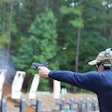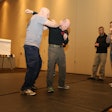There is life after law enforcement. And in New York state, it sits within 17,000 lush acres of the Oneida Indian Nation. Here is where officers with decades of experience, including those who have retired from police work at other agencies throughout the Empire State, can begin a "second career" in the profession they love.
The Oneida Indian Nation Police Department fields veterans like Capt. Robert L. Ryan, who has worked in law enforcement for 37 years, including 21 years with the Madison County Sheriff's Department-nearly 10 of which were spent as sheriff.
"We started from ground zero and built this department up," says Ryan, who joined the tribal police department when it was created in 1993.
Today, the Oneida Indian Nation employs 38 sworn, non-native officers who previously worked for about two dozen different law enforcement agencies. They bring an impressive, combined total of 1,060 years of prior police experience as state troopers, police chiefs, deputies, sheriffs, and municipal police officers.
This arrangement is possible because the Oneida Indian Nation is a federally recognized sovereign government; it is its own, distinct governing authority under federal law. Employees of the Indian Nation do not operate under the New York State Retirement System, which covers most police agencies.
"In New York, if you retire and collect a [state] pension, you can't work for another government agency unless you get a waiver," says Arthur F. Pierce, the Nation's Commissioner of Public Safety and a 34-year policing veteran himself. "That's favorable for the Oneida Nation. Because of their sovereignty, they can hire individuals who hit the ground running, and make use of all their policing experience.
"Because of the Nation's sovereignty ... our officers can work for the Oneida Indian Nation without jeopardizing their retirement."
But not only officers benefit from the arrangement. The benefits of fielding an experienced police force are enjoyed by the roughly 1,000-member Oneida Indian Nation, as well as its nearly 5,000 non-Indian employees, and patrons of thriving Oneida enterprises like the Turning Stone Resort & Casino, which attracts 4.5 million visitors annually.
Life as a tribal police officer isn't much different from that of a state, county, or municipal law enforcement professional, Pierce says. Tribal officers work 12-hour shifts and respond to a wide variety of calls. They have access to quality training and modern equipment. And the tribal department's multi-pronged mission is a familiar one: Preserve the peace. Protect property. Prevent, detect, and investigate crime.
Oneida tribal police are charged with enforcing federal and state laws, as well as the laws and ordinances of the Oneida Indian Nation. As deputy special officers of the Bureau of Indian Affairs, tribal officers also function as federal officers when investigating federal crimes that occur on Oneida land.
"Indian policing issues are very complex," Pierce admits. "In central New York, it boils down to the nature of the crime, the victim and perpetrator in terms of their race, and the classification of the crime itself. Based on the classification of the crime, the case could end up in tribal, state, or federal court."
The formation of the Oneida Indian Nation Police Department roughly follows the economic rebirth of the tribe itself.
Ancestral lands of the Oneida, a member of the Haudenosaunee, or Iroquois Confederacy, once numbered in the millions of acres. In the late 1700s, New York drew up a treaty that set aside just 300,000 acres for the Oneidas' future use. Over the centuries, unscrupulous dealings eroded Oneida land even further; by the mid-1960s, the impoverished tribe's land holdings had dwindled to a mere 32 acres.
Following the federal government's approval of a gaming compact in 1993, the Oneida-who had once subsisted on meager earnings from on-reservation tobacco sales and bingo games-experienced an economic turnaround. The Oneida Nation, which operates a destination resort and casino that attracts entertainers, sporting events, and visitors from around the world, is now the third-largest employer in central New York.
The same year, Oneida created its own police force. Pierce started the department under the direction of the governing Men's Council and Clan Mothers.
The Oneida Nation "wanted a higher level of certainty with regard to emergency response, and the only way you have to assure that is to have their own police force," says Pierce. "They would have 24-7 coverage without too many impediments."
Having a tribal police force also gave the Oneida "control over criminal matters and criminal investigations on their own land," he notes.
The acreage of that land, however, creates its own law enforcement issues. One minute, an officer might be called upon to round up stragglers from the Nation's 650 head of Black Angus cattle, or to confront "deer jackers" hunting in remote areas. The next, he might be dispatched to a gas-skip call at an urban convenience store, a casino patron having a heart attack, or a mass-casualty wreck on the highway.
In addition to fighting crime, tribal officers also work to prevent crime. Especially when it involves the Nation's elders and children, who are seen as vital, cherished connections to the past and future, respectively.
"Our Nation's police officers ... instituted a program to help the elders with crime prevention, and their personal safety and security," says Lt. Joseph Smith, who served nearly 32 years with the New York State Police before joining the Oneida Indian Nation force. "A number of these programs center around dinners they have at Ray Elm Children and Elders Center," a vibrant, crescent-shaped activity center that the Oneida opened in 1998.
That same year, the Oneida Indian Nation Police became the first tribal police department in the United States to become internationally accredited through the Commission on Accreditation for Law Enforcement Agencies. It remains one of only seven CALEA-accredited agencies in the entire state.
Bringing experience to the table is an essential part of hiring on as a tribal officer. In fact, one requirement for those seeking a position with the department is to have a minimum of five years of law enforcement experience as a police officer certified by a New York State Division of Criminal Justice Services.
No doubt, as the Indian Nation grows, so will its police department, Pierce observes. That will provide even more opportunities for veteran officers to continue to protect and serve a variety of communities.
"It's a tremendous benefit," he says. "You don't have to leave the state to practice what you've spent your entire adult life learning and becoming proficient at."
Bryn Bailer, a former newspaper reporter, is a contributing editor for Police. By night, she is a member of the Tucson (Ariz.) Police Department Communications Division.















